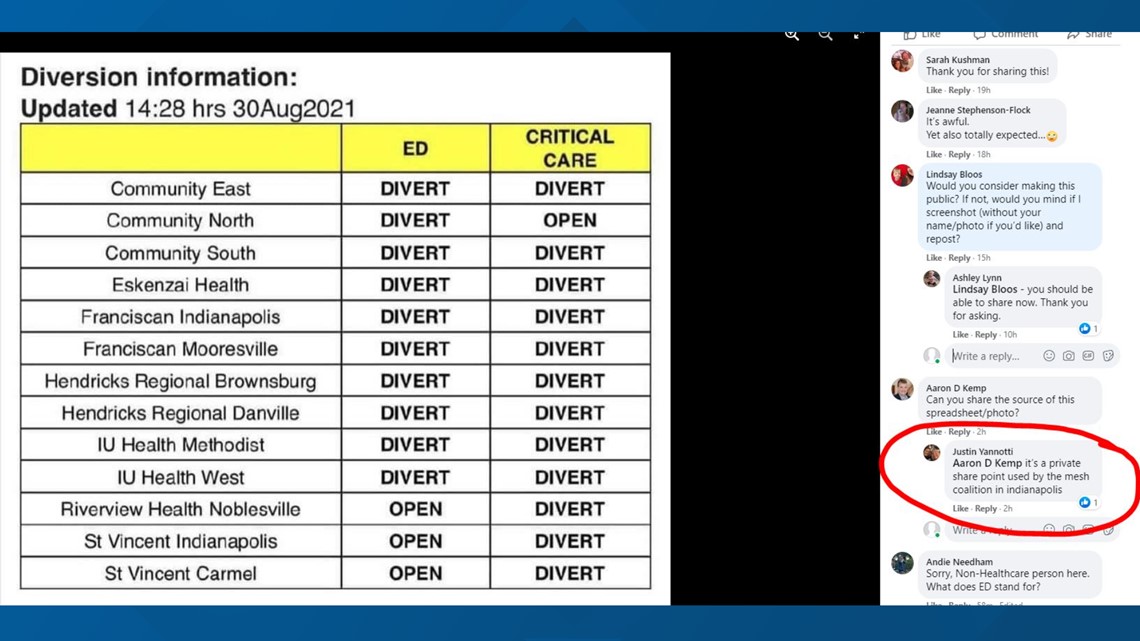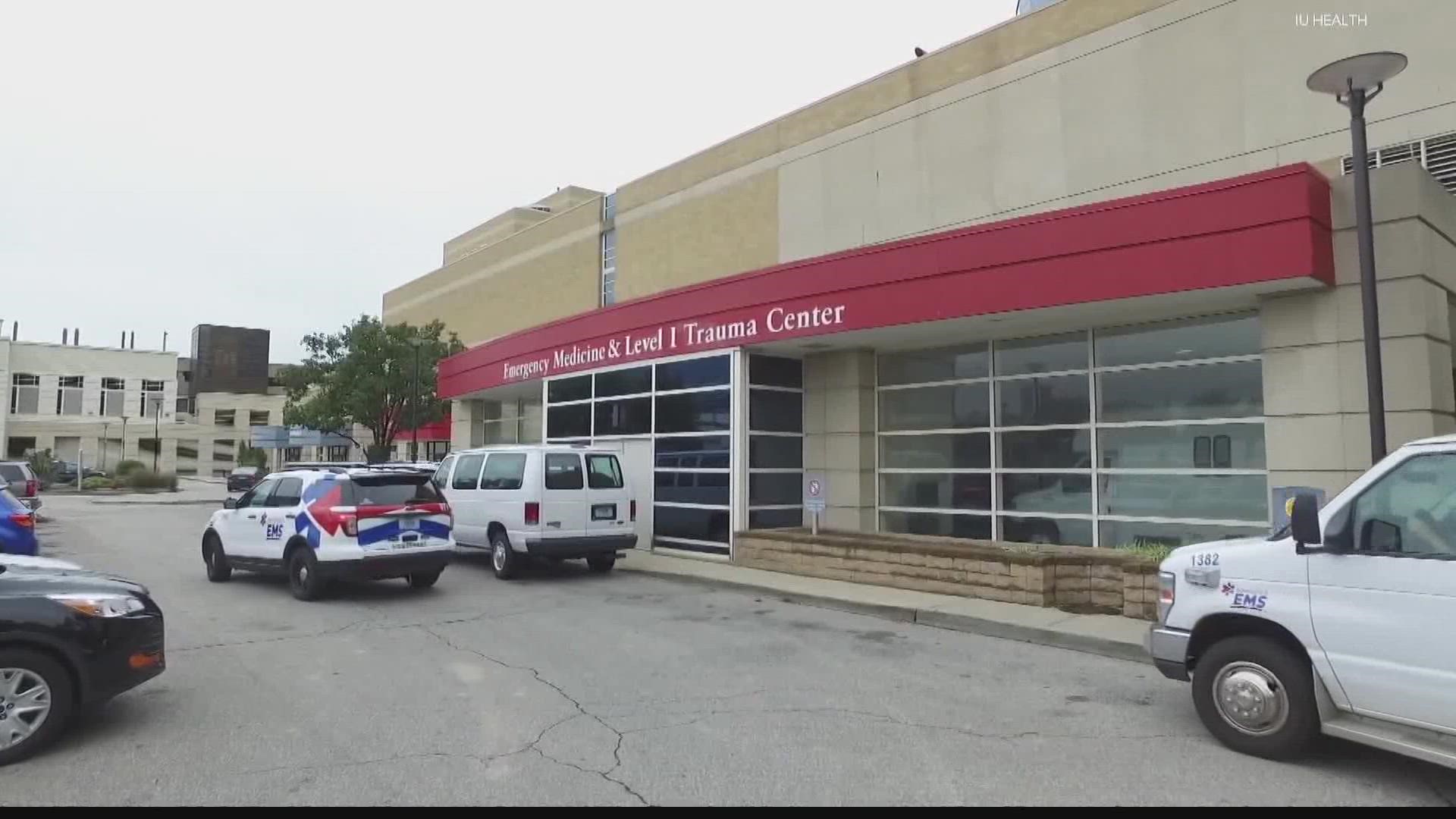INDIANAPOLIS — A chart that is circulating widely on Facebook and other social media platforms this week allegedly shows “diversion information” for 13 Indianapolis-area hospitals. It claims almost of all them were diverting ambulances away from their emergency rooms and intensive care units Monday, Aug. 30, at 2:28 p.m.


Multiple viewers have emailed 13News VERIFY to ask if the information in the chart is accurate and whether local hospitals are turning away patients. If the information is true, it would mean multiple area hospitals experienced situations in which they were too full to accept ambulances carrying patients who needed critical care for serious injuries and illnesses.
THE QUESTION
Is it true that many Indianapolis-area hospitals have been diverting ambulances away from their emergency rooms and intensive care units?
THE SOURCES
- Dr. Robin Lenyard, Community Hospitals chief medical officer
- David Crabb, Eskenazi Hospital chief medical officer
- Riverview Health Noblesville
- Indianapolis EMS
THE ANSWER
Yes, most hospitals in the Indianapolis area have – at some point this week – notified ambulance services that their emergency rooms and/or ICUs were in “diversion” status. The status changes frequently, based on the number of patients needing emergency and critical care at a specific hospital any given moment. While there are multiple reasons that hospitals might need to divert patients, the most recent surge of patients requiring critical care for COVID-19 is the most common reason given for area hospitals having full ERs and ICUs.
WHAT WE FOUND
The information in the chart originated from an organization called the Managed Emergency Surge for Healthcare, better known as the MESH Coalition. It is a nonprofit partnership that coordinates hospitals to respond to emergency and crisis events, and it constantly monitors capacity at metro area hospitals. But it is important to point out the actual chart circulating on social media did not come from MESH. In fact, the organization will not even discuss the chart with 13News.
“MESH does not provide this type of information to the media. This is hospital proprietary information and would need to be obtained from the hospitals of interest,” wrote MESH executive director Jennifer Pitcher, in response to multiple inquiries from 13News VERIFY.
While MESH does not share diversion information with the media, it does provide the information to area hospitals and ambulance services to ensure they are directing incoming ambulances to hospitals that have enough room to care for patients.
Several of those hospitals and Indianapolis EMS confirmed the information contained in the online chart is accurate.
“Yes, diversions were taking place earlier this week, but that chart is not in a format that comes from MESH,” said IEMS spokesman Brian Van Bokkelen. “It’s pretty clear someone with access to the MESH information took it and made their own chart and shared it online.”
The chart provides information for 13 hospitals. It shows three of the facilities’ emergency rooms and one intensive care unit were listed as “Open,” meaning those ERs and ICUs were accepting incoming patients as usual.
The remaining 10 ERs and 12 ICUs are listed as “Divert,” showing they were notifying ambulances to not bring any additional patients. Walk-in patients are not notified of diversion status and are not turned away from hospitals, even during diversions.
“Right now, our hospitals -- all of them throughout all of the doughnut counties -- are running incredibly full,” said Dr. Robin Ledyard, the chief medical officer for Community Health Network’s three metro-area hospitals. “Diversion means we have put out the message to EMS ‘Do not come here. We feel we are too full to take another patient.’”
Local hospitals say it is very important to point out the diversion chart circulating online covers a very specific date and time (Monday, Aug. 30 at 2:28 p.m.). The diversion status of local hospitals is constantly changing, according to Eskenazi Hospital chief medical officer Dr. David Crabb.
“In the graphic that was seen, it was a snapshot. And a minute later, another hospital could have gone on or come off [diversion status],” Crabb told 13News. “It’s minute to minute information that guides the ambulance services to know where to go.”
Under normal circumstances, patients needing emergency or urgent care can request an ambulance crew take them to a specific hospital of their choice.
But if several local hospitals declare they are in diversion status, it triggers a condition called Alternate Destination Protocol. ADP situations require every ambulance in the metro area to contact a central dispatcher who directs each EMT crew to an available emergency room or ICU.
“Alternate Destination Protocol is like having an air traffic control for hospitals,” explained Van Bokkelen. “It tends to be very fluid. It might be for 20 minutes or a half hour and then back to normal. Sometimes, it lasts longer. It just depends on the day.”
Are hospitals still diverting some patients?
Since the MESH Coalition will not release its up-to-date diversion information, it is nearly impossible for the public to know which hospital ERs and ICUs are diverting incoming ambulances. Some hospitals will not release the information, even when asked directly. Indiana University hospitals and Hendricks Regional hospitals did not respond to multiple inquiries from 13News about their diversion status.
Metro-area hospitals in the Community Health Network have been diverting incoming ambulances about 40% of the time during the past week, according to Ledyard.
“Today, right now, as we speak, I know that Community South is still on diversion,” she said late Wednesday afternoon. “Community East happens to not be on diversion right now. And Community North is on critical care [ICU] diversion. We may be able to take care of you at a lower level of care, but our ICU at Community North is full, is what that means.”
Eskenazi Hospital has also had several periods of diversion. “We’re not on diversion right now, but we have over the last 24 hours. We were for several hours,” Crabb said on Wednesday.
Riverview Health said its hospital in Noblesville has been in diversion status eight times since the start of August because its beds are full with patients. (It did not divert any patients in June or July.)
Ascension St. Vincent confirms it has experienced diversions, as well.
“In the last week, our 86th Street hospital has been on and off diversion,” explained Ascension spokeswoman Danielle Eagleson. “Like all hospitals in central Indiana, Ascension St. Vincent has been seeing an increase of patients in need of emergency and critical care,” she added, emphasizing that patients who walk into St. Vincent hospitals will get the care they need regardless of diversion status.
What’s causing hospitals to divert patients?
The medical centers contacted by 13News say the reason for the increased diversions should come as no surprise as the latest surge of COVID-19 patients places a significant strain on hospital resources.
“COVID is the thing that’s pushing us all over the limit so that we are bursting at the seams in our hospitals,” said Ledyard, pointing out that 20% to 30% of all patients currently in Community hospitals are there due to coronavirus. “We are seeing a surge that has a steeper slope than we even saw last winter, and so there is no doubt when you see that diversion graph, it is due to this COVID surge.”
Crabb says Eskenazi is also experiencing “more and more people needing to be in the hospital” due to the virus, which is the single largest factor contributing to the higher rates of ambulance diversion. But he believes there are other reasons, too.
“Added on top of that is increased rates of violence, increased rates of drug overdoses, and the effects of people delaying care over the past 18 months and not coming in with problems related to not seeking usual outpatient care,” he said.
And at the same time, hospitals are also having trouble finding enough staff, which is also contributing to the need to divert incoming ambulances away from some emergency rooms and intensive care units.
Both medical directors say if at any point all local hospitals are diverting patients, then no hospitals are allowed to divert patients. It means during crisis situations, ambulances are still directed to take patients to the nearest hospital that can meet their medical needs. The same is true in any life threatening emergency in which patients can be transported to the closest hospital.
Several hospitals have now announced they are postposing patients’ elective surgeries due to the current strain on hospital staff and the limited number of beds available to incoming patients. They hope the move will limit the amount of time their ERs and ICUs need to divert patients in serious need of medical care.
Ledyard believes the fastest way to end the diversions and for hospitals to return to normal operations is through vaccination.
“We really need folks to continue to take the pandemic seriously,” she said. “98% of our COVID patients in the hospital are unvaccinated. We still have to stress vaccines, the safety of those, to get us out of this pandemic.”
Update: Following publication, IU Health spokeswoman Emily Garrett responded to questions from 13News and acknowledged Methodist Hospital in Indianapolis has also experienced diversion status. “IU Health Methodist Hospital has been on diversion once in the past week,” she said.

